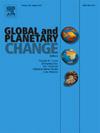Lake energy balance response to 21st century warming in the tropical high Andes
IF 4
1区 地球科学
Q1 GEOGRAPHY, PHYSICAL
引用次数: 0
Abstract
The response of Andean high-alpine lakes (>4000 m above sea level) to atmospheric warming is poorly understood, in part due to a lack of long-term limnological and meteorological observations. Here, we use in situ observations, reanalysis data, satellite-derived data, and climate modeling output data paired with a one-dimensional lake energy balance model to investigate the response of lake thermal properties to observed and projected 21st century warming in the tropical high Andes of Peru. The lake model configuration is based on Lake Sibinacocha (13.86°S, 71.02°W, 4860 m a.s.l.), the largest high-alpine lake in the Andes and one of the few such lakes with temperature observations sufficient for model calibration. Relationships between recent air and lake temperature changes were investigated using the model forced with 21st-century ERA5-Land climate reanalysis data, CERES satellite-based observations, and future relationships were investigated using two CMIP6 future climate scenarios with CESM2 (SSP2–4.5 and SSP5–8.5). Results show that Sibinacocha whole-lake average temperature stayed relatively consistent between 2000 and 2023 due to high interannual variability. Lake Sibinacocha temperatures also display interannual variability that aligns with air temperature variations, suggesting that broad climatic teleconnections that affect Andean air temperatures also influence lake temperature and stratification. Under the SSP2–4.5 and SSP5–8.5 scenarios, the model indicates an acceleration of Lake Sibinacocha's whole-lake warming rate. By 2091–2100, Lake Sibinacocha is projected to increase 2.5 °C to 5.9 °C. Lake Sibinacocha is projected to warm unevenly, with greater warming in the top 20 m and austral spring, contributing to increased weak stratification in spring. Lake Sibinacocha is anticipated to respond more slowly to warming simply due to its large size. Therefore, our results should be considered a conservative end-member for other lakes in the tropical high Andes, which, due to their shallower sizes, will likely respond more quickly to atmospheric warming.
求助全文
约1分钟内获得全文
求助全文
来源期刊

Global and Planetary Change
地学天文-地球科学综合
CiteScore
7.40
自引率
10.30%
发文量
226
审稿时长
63 days
期刊介绍:
The objective of the journal Global and Planetary Change is to provide a multi-disciplinary overview of the processes taking place in the Earth System and involved in planetary change over time. The journal focuses on records of the past and current state of the earth system, and future scenarios , and their link to global environmental change. Regional or process-oriented studies are welcome if they discuss global implications. Topics include, but are not limited to, changes in the dynamics and composition of the atmosphere, oceans and cryosphere, as well as climate change, sea level variation, observations/modelling of Earth processes from deep to (near-)surface and their coupling, global ecology, biogeography and the resilience/thresholds in ecosystems.
Key criteria for the consideration of manuscripts are (a) the relevance for the global scientific community and/or (b) the wider implications for global scale problems, preferably combined with (c) having a significance beyond a single discipline. A clear focus on key processes associated with planetary scale change is strongly encouraged.
Manuscripts can be submitted as either research contributions or as a review article. Every effort should be made towards the presentation of research outcomes in an understandable way for a broad readership.
 求助内容:
求助内容: 应助结果提醒方式:
应助结果提醒方式:


